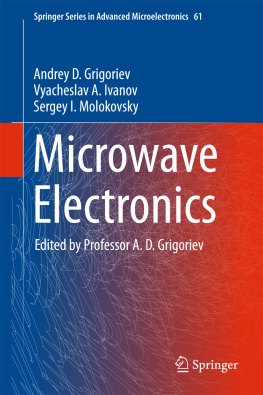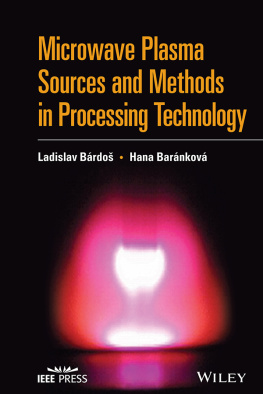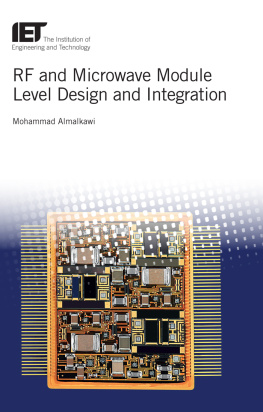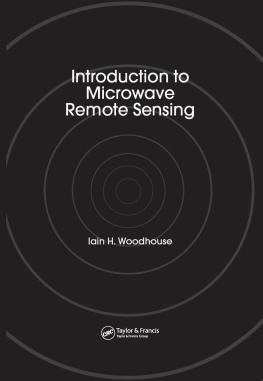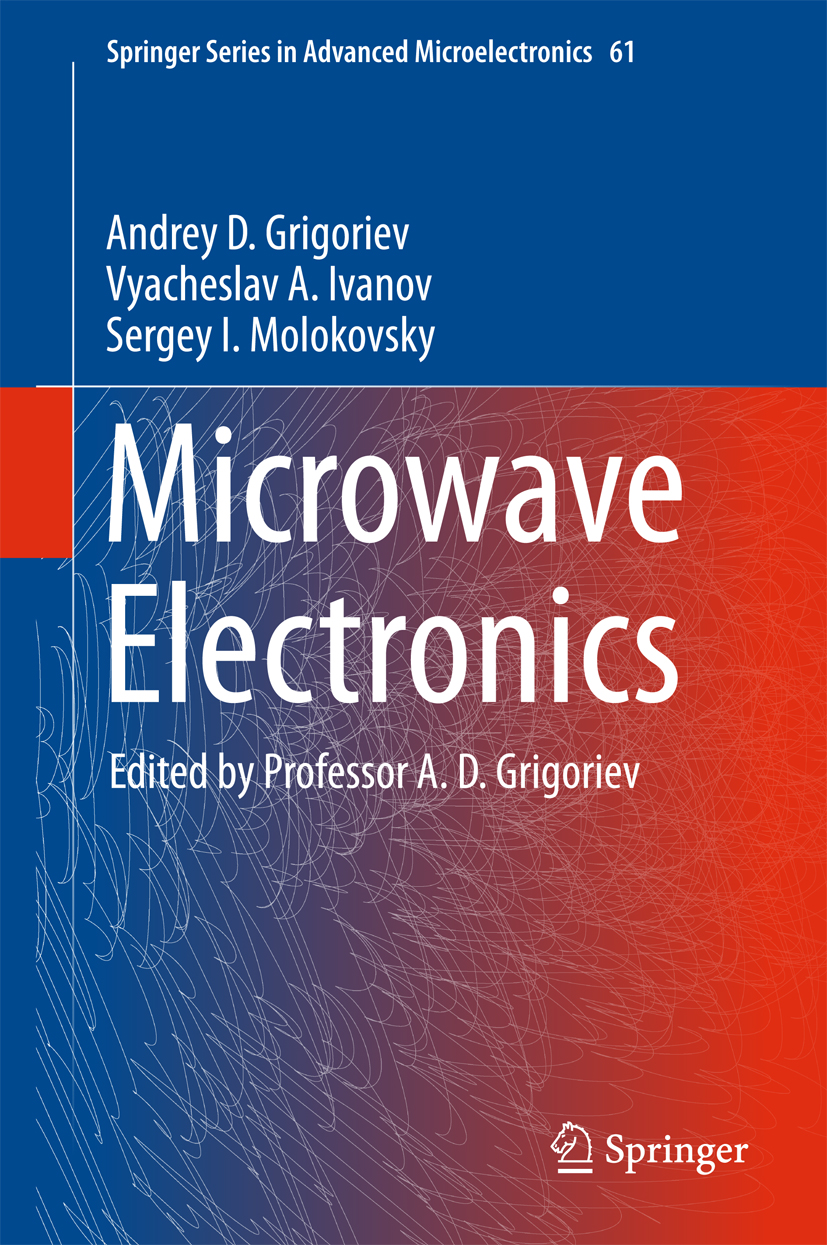Volume 61
Springer Series in Advanced Microelectronics
Series Editors
Kukjin Chun
Seoul, Korea, Republic of (South Korea)
Kiyoo Itoh
Tokyo, Japan
Thomas H. Lee
Stanford, CA, USA
Rino Micheloni
Vimercate (MB), Italy
Takayasu Sakurai
Tokyo, Japan
Willy M. C. Sansen
Leuven, Belgium
Doris Schmitt-Landsiedel
Mnchen, Germany
The Springer Series in Advanced Microelectronics provides systematic information on all the topics relevant for the design, processing, and manufacturing of microelectronic devices. The books, each prepared by leading researchers or engineers in their fields, cover the basic and advanced aspects of topics such as wafer processing, materials, device design, device technologies, circuit design, VLSI implementation, and subsystem technology. The series forms a bridge between physics and engineering and the volumes will appeal to practicing engineers as well as research scientists.
More information about this series at http://www.springer.com/series/4076
Andrey D. Grigoriev , Vyacheslav A. Ivanov and Sergey I. Molokovsky (deceased)
Microwave Electronics
Edited by Professor A. D. Grigoriev
Andrey D. Grigoriev
Saint-Petersburg Electrotechnical University LETI, Saint-Petersburg, Russia
Vyacheslav A. Ivanov
Saint-Petersburg Electrotechnical University LETI, Saint-Petersburg, Russia
Sergey I. Molokovsky (deceased)
Saint-Petersburg Electrotechnical University LETI, Saint-Petersburg, Russia
ISSN 1437-0387 e-ISSN 2197-6643
Springer Series in Advanced Microelectronics
ISBN 978-3-319-68890-9 e-ISBN 978-3-319-68891-6
https://doi.org/10.1007/978-3-319-68891-6
Library of Congress Control Number: 2017957671
Copyright for the English version is with the authors.
Springer International Publishing AG 2018
This work is subject to copyright. All rights are reserved by the Publisher, whether the whole or part of the material is concerned, specifically the rights of translation, reprinting, reuse of illustrations, recitation, broadcasting, reproduction on microfilms or in any other physical way, and transmission or information storage and retrieval, electronic adaptation, computer software, or by similar or dissimilar methodology now known or hereafter developed.
The use of general descriptive names, registered names, trademarks, service marks, etc. in this publication does not imply, even in the absence of a specific statement, that such names are exempt from the relevant protective laws and regulations and therefore free for general use.
The publisher, the authors and the editors are safe to assume that the advice and information in this book are believed to be true and accurate at the date of publication. Neither the publisher nor the authors or the editors give a warranty, express or implied, with respect to the material contained herein or for any errors or omissions that may have been made. The publisher remains neutral with regard to jurisdictional claims in published maps and institutional affiliations.
Printed on acid-free paper
This Springer imprint is published by Springer Nature
The registered company is Springer International Publishing AG
The registered company address is: Gewerbestrasse 11, 6330 Cham, Switzerland
Preface
Microwave electronics is currently a large and rapidly developing branch of science and technology, which has a huge impact on the countrys economy and defense capability. Most telecommunication systems, radio astronomy, accelerative techniques, thermonuclear machines, technology and medicine, and practically all types of weapons use microwave electronics technology to some extent. These achievements are mostly due to the use of new interaction mechanisms of charged particle fluxes with electromagnetic fields, use of new materials, and new manufacturing technologies of microwave electronics devices and systems.
The physical laws and phenomena used in microwave electronic devices, and the operating principles of these devices, along with their design, characteristics and parameters form the subject of the Microwave Electronics discipline. These laws, phenomena and devices are studied more deeply in the masters programs of the corresponding field.
Unfortunately, the textbooks and manuals on this discipline existing at the time of preparation of this manuscript were either published a long time ago and are out of date, or do not cover all the disciplines content. In particular, there are no modern manuals considering the processes taking place in a vacuum and in semiconductor microwave devices from the unified position.
The proposed textbook describes in reasonable detail the main interaction mechanisms of the microwave electromagnetic field with charged particles in a vacuum and in a solid. Much attention is paid to the peculiarities of these mechanisms using vacuum and solid-state microwave electronic devices. This theoretical part is supplemented by a description of the design of the devices, their parameters and characteristics.
The authors hope that the proposed textbook will assist students studying microwave electronics and related areas.
The book will also be useful to postgraduates and specialists engaged in the development and application of microwave electronics products.
The textbook is based on the lecture course taught by the authors to bachelors and masters in St. Petersburg State Electrotechnical University LETI.
The authors express also their gratitude to V. B. Yancevich for valuable advices and assistance in preparing the book for publication. The authors are also sincerely grateful to V. B. Yankevich, the Head of the LETI Radio-technical Electronics Department, for valuable advice and invaluable assistance in preparing the manuscript for publication.
The Introduction, Chapters 1, 3, 5... 8, Chapter 10 and Appendix C was written by A. D. Grigoriev, Chapter 12... 14 and Appendix A was written by V. A. Ivanov, Chapters 2, 4 and 11 was written together by A. D. Grigoriev and V. A. Ivanov, Chapter 9 and Appenix B was written together by A. D. Grigoriev and S. I. Molokiovsky.
Vyacheslav A. Ivanov
Saint-Petersburg, Russia
Nature is simple in its laws ,
but immeasurably rich and diverse in their applications!
G. W. Leibniz
Introduction
The subject of microwave electronics is the study of the physical processes occurring in electronic devices intended for generating, amplifying and converting microwave band electromagnetic oscillations, as well as the development of methods for the design and engineering of these devices and recommendations for their application.
In accordance with the recommendations of the International Electrotechnical Commission the microwave range is the part of the electromagnetic oscillations spectrum from 3 10 8 to 3 10 11 Hz (300 MHz to 300 GHz), that corresponds to wavelengths in a vacuum from 1 to 1 mm. The microwave range is divided into several bands:
ultrahigh frequencies (UHF or decimeter waves)the frequency band from 300 MHz to 3 GHz (wavelengths are 1 m to 10 cm);
superhigh frequencies (SHF or centimeter waves)the frequency band from 3 to 30 GHz (wavelengths are 101 cm);

